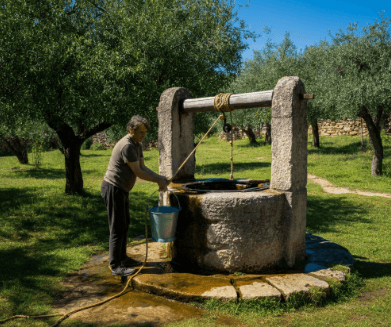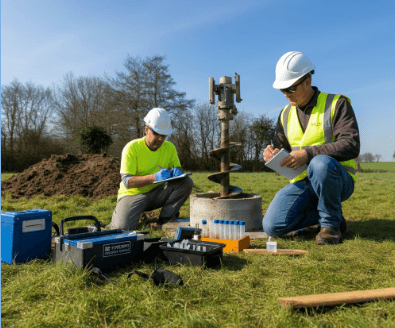Did you know that over 2 million Americans live without access to public water systems, relying on private wells and alternative water sources to meet their daily needs? For landowners in rural areas, understanding how people without public water supply obtain water for their land is crucial for making informed property decisions and ensuring long-term sustainability. According to the EPA, approximately 15% of the U.S. population relies on private wells, with many rural properties requiring innovative water solutions, ranging from drilled wells to rainwater harvesting systems. Nearly 23 million people depend on domestic wells that may be contaminated or inadequate. Understanding your water options before building or buying rural property can save you money and avoid costly errors. Steve Daria and Joleigh, experienced real estate investors and cash land buyers, have helped many landowners address water access challenges and get the most out of their property investments. In this comprehensive guide, you’ll discover proven methods that people without public water supply obtain water for their land, from traditional well drilling to modern water delivery systems and everything in between.
Key Points
- Drilling a Private Water Well: Drilling a well is the most common solution for rural landowners who lack access to municipal water. A professional drilling company can access underground aquifers and install a pump system to bring fresh water to your property.
- Install a Rainwater Collection System: Rainwater harvesting captures and stores precipitation from your roof and other surfaces in large tanks. This eco-friendly method can provide substantial water for irrigation, livestock, and household use, provided it is properly filtered.
- Haul Water Using Tank Trucks: Water delivery services can fill large storage tanks on your property with potable water from approved sources. This option is a good choice for properties with low water needs or as a temporary fix while permanent water sources are being developed.
- Utilize Spring Water Sources: Natural springs located on or near your property can provide a continuous supply of fresh groundwater. Springs require proper testing and may need development to ensure adequate flow and water quality for your intended uses.
- Combine Multiple Water Sources: Many successful landowners use a combination of methods, such as wells and rainwater collection, to ensure a reliable supply year-round. This approach offers backup options and can help reduce costs while effectively meeting all your water needs.
What is the difference between public water supply and private water sources?
A public water supply is managed and operated by city or municipal systems, delivering water to homes through a vast network of pipes, treatment plants, and regular monitoring to make sure the water is safe to drink.
These utilities are regulated by the EPA and local agencies to meet strict health and quality standards, making them a convenient and reliable choice for most urban and suburban areas.
In contrast, private water sources require landowners to secure their water, which can come from wells, springs, rainwater collection systems, or even trucking in water when needed.

Since local utilities do not manage these sources, property owners are responsible for testing, maintenance, and any repairs needed to ensure safe and consistent water use.
It’s important to note that people without public water supply obtain water through these private options, which may involve more upfront costs and ongoing work.
Private sources offer independence and can be a necessity in rural or remote areas where city water isn’t available.
However, safety and reliability depend on the owner’s diligence in properly maintaining the system and regular water testing.
The choice between options often depends on the location of a property and the resources available to each landowner.
Get Started: Get Your Cash Offer Below…
We are direct land buyers. There are no commissions or fees and no obligation whatsoever. Start below by sharing where your property is and where we can send your offer…
How many Americans live without access to public water systems?
Over 2 million Americans currently live without access to public water systems, relying instead on private water sources for their daily needs.
About 15% of the U.S. population relies on private wells or individual water sources instead of municipal systems, according to the EPA.
This means that roughly 43 million Americans obtain their water from private sources, although not all do so by choice.
Rural and remote communities are most affected by this lack of public water infrastructure, often due to the high costs of extending water lines to sparsely populated areas.
Many of these people without public water supply obtain water for their land through drilling wells, collecting rainwater, or using water delivery services.
The problem is particularly severe in states like Alaska, where over 30% of residents lack access to public water systems.
Native American communities face even greater challenges, with some reservations having water access rates as low as 50%.
These statistics highlight the ongoing need for creative water solutions in underserved areas across America.
How much does it cost to drill a well for rural property?
- Basic Drilling Costs Range from $15 to $50 Per Foot: Most well drilling companies charge between $15 to $50 per foot of depth, depending on your location and soil conditions. A typical residential well ranges from 100 to 400 feet deep, resulting in basic drilling costs between $1,500 and $20,000.
- Well Pump Installation Adds $500 to $2,000: After drilling, you’ll need a submersible pump to bring water to the surface. Pump installation typically costs between $500 and $2,000, depending on the pump size and the depth requirements.
- Permits and Testing Cost $300 to $1,500: Most states require drilling permits and water quality testing before you can use your well. These essential safety steps typically cost between $300 and $1,500 in total.
- Casing and Well Head Protection Costs $1,000 to $3,000: Steel or PVC casing protects your well from contamination and structural damage. This protective barrier typically adds $1,000 to $3,000 to your total project cost.
- Electrical Work and Pressure Tank Add $800 to $2,500: Connecting electricity to your pump and installing a pressure tank costs $800 to $2,500. This ensures that people without public water supply obtain water for their land with consistent water pressure throughout their property.
Is rainwater harvesting legal and effective for land water needs?
Rainwater harvesting is legal across the U.S., with regulations differing by state.
Most states actively encourage this practice, with some offering tax incentives or rebates for installing collection systems.
The effectiveness depends on your local rainfall patterns, roof size, and water storage capacity, but it can provide substantial water for various land uses.
A 2,000-square-foot roof can collect around 1,200 gallons of water from one inch of rain, providing a dependable water source.
This method is particularly valuable as part of how people without a public water supply obtain water for their land, especially when combined with other water sources, such as wells.
Quality gutters, first-flush diverters, and proper storage tanks ensure clean water collection and prevent contamination.
Many rural property owners find that rainwater harvesting significantly reduces their water costs while providing a backup supply during dry periods.
The system requires minimal maintenance once installed, making it a cost-effective long-term solution for irrigation, livestock watering, and household use with proper filtration.
How do I test if my land has good groundwater for drilling a well?
- Check Your Neighbors’ Wells and Water Records: Contact nearby property owners to ask about their well depth, water quality, and flow rates. Local well drilling companies can also share general information about groundwater conditions in your specific area.
- Review Geological Survey Maps and Reports: Visit your state’s geological survey website to find groundwater maps and aquifer information for your region. These official reports show water table depths and help predict how people without public water supply obtain water for their land successfully.
- Hire a Professional Hydrogeologist for Site Assessment: A qualified hydrogeologist can analyze soil samples, review topography, and conduct geophysical surveys to locate underground water sources. This expert evaluation provides the most accurate prediction of well success before you invest in drilling.
- Look for Natural Water Indicators on Your Property: Check for existing springs, wetland areas, or year-round green vegetation that might indicate shallow groundwater. These natural signs often reveal where underground water flows closest to the surface.
- Test Drill a Pilot Hole Before Full Well Installation: Some drilling companies offer test drilling services to confirm the presence and quality of water before completing the full well. This approach shows exactly how people without public water supply obtain water while minimizing financial risk.

How quickly can I get water access established on new land?
Water access on new land can be established in a matter of days to several weeks, depending on your chosen method and specific property factors.
Water delivery services provide the fastest solution, often delivering potable water to storage tanks within 24-48 hours.
Rainwater collection systems are another quick option, typically installed within 1-2 weeks; however, you’ll need to wait for rain to fill your tanks.
Drilling a new well typically takes 2-6 weeks, encompassing permit acquisition, drilling, pump installation, and water testing.
The permitting process itself typically takes 1-3 weeks, depending on local requirements.
Developing a spring as a water source may take 4-8 weeks, factoring in channeling and water quality testing.
Seasonal weather, soil conditions, and contractor schedules can all impact overall timelines.
Learning how people without public water supply obtain water for their land is essential for making the best choice.
Ready to start? Contact a water solutions expert for a free, personalized assessment today!
**NOTICE: Please note that the content presented in this post is intended solely for informational and educational purposes. It should not be construed as legal or financial advice or relied upon as a replacement for consultation with a qualified attorney or CPA. For specific guidance on legal or financial matters, readers are encouraged to seek professional assistance from an attorney, CPA, or other appropriate professional regarding the subject matter.
